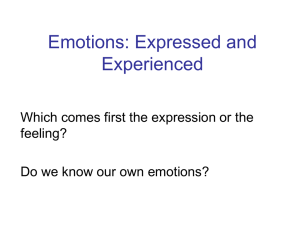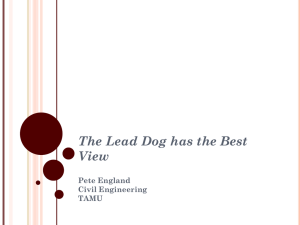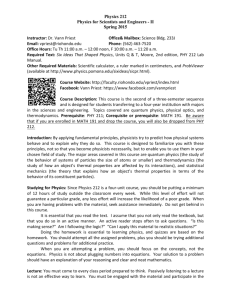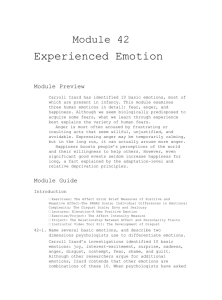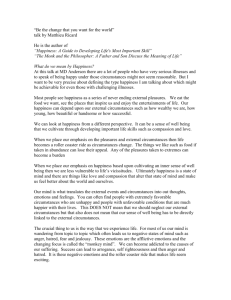Ψ AP Psychology – Chapter Study Guide Chapter 13: Emotion Rd
advertisement
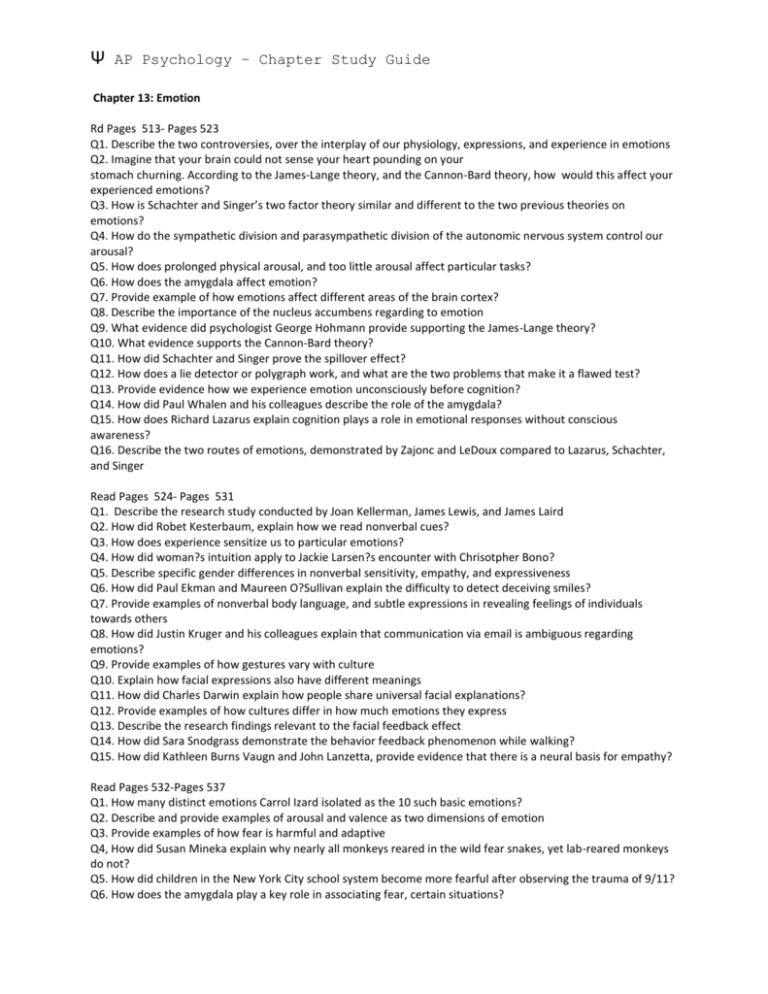
Ψ AP Psychology – Chapter Study Guide Chapter 13: Emotion Rd Pages 513- Pages 523 Q1. Describe the two controversies, over the interplay of our physiology, expressions, and experience in emotions Q2. Imagine that your brain could not sense your heart pounding on your stomach churning. According to the James-Lange theory, and the Cannon-Bard theory, how would this affect your experienced emotions? Q3. How is Schachter and Singer’s two factor theory similar and different to the two previous theories on emotions? Q4. How do the sympathetic division and parasympathetic division of the autonomic nervous system control our arousal? Q5. How does prolonged physical arousal, and too little arousal affect particular tasks? Q6. How does the amygdala affect emotion? Q7. Provide example of how emotions affect different areas of the brain cortex? Q8. Describe the importance of the nucleus accumbens regarding to emotion Q9. What evidence did psychologist George Hohmann provide supporting the James-Lange theory? Q10. What evidence supports the Cannon-Bard theory? Q11. How did Schachter and Singer prove the spillover effect? Q12. How does a lie detector or polygraph work, and what are the two problems that make it a flawed test? Q13. Provide evidence how we experience emotion unconsciously before cognition? Q14. How did Paul Whalen and his colleagues describe the role of the amygdala? Q15. How does Richard Lazarus explain cognition plays a role in emotional responses without conscious awareness? Q16. Describe the two routes of emotions, demonstrated by Zajonc and LeDoux compared to Lazarus, Schachter, and Singer Read Pages 524- Pages 531 Q1. Describe the research study conducted by Joan Kellerman, James Lewis, and James Laird Q2. How did Robet Kesterbaum, explain how we read nonverbal cues? Q3. How does experience sensitize us to particular emotions? Q4. How did woman?s intuition apply to Jackie Larsen?s encounter with Chrisotpher Bono? Q5. Describe specific gender differences in nonverbal sensitivity, empathy, and expressiveness Q6. How did Paul Ekman and Maureen O?Sullivan explain the difficulty to detect deceiving smiles? Q7. Provide examples of nonverbal body language, and subtle expressions in revealing feelings of individuals towards others Q8. How did Justin Kruger and his colleagues explain that communication via email is ambiguous regarding emotions? Q9. Provide examples of how gestures vary with culture Q10. Explain how facial expressions also have different meanings Q11. How did Charles Darwin explain how people share universal facial explanations? Q12. Provide examples of how cultures differ in how much emotions they express Q13. Describe the research findings relevant to the facial feedback effect Q14. How did Sara Snodgrass demonstrate the behavior feedback phenomenon while walking? Q15. How did Kathleen Burns Vaugn and John Lanzetta, provide evidence that there is a neural basis for empathy? Read Pages 532-Pages 537 Q1. How many distinct emotions Carrol Izard isolated as the 10 such basic emotions? Q2. Describe and provide examples of arousal and valence as two dimensions of emotion Q3. Provide examples of how fear is harmful and adaptive Q4, How did Susan Mineka explain why nearly all monkeys reared in the wild fear snakes, yet lab-reared monkeys do not? Q5. How did children in the New York City school system become more fearful after observing the trauma of 9/11? Q6. How does the amygdala play a key role in associating fear, certain situations? Ψ AP Psychology – Chapter Study Guide Q7. Describe an individuals response to fear if there is damage to the amygdala and hippocampus? Q8. Describe individuals who have a short version of a gene that influences the amygdala's response to frightening situations Q9. How do adolescents deal with anger according to their gender? Q10. Describe how anger is maladaptive to us, and yet beneficial Q11. Describe the short-term advantages and long-term disadvantages of venting our anger Q12. Describe the two suggestions in the text to handle our anger Q13. How does anger communicate strength and competence? Q14. Describe Charoltte Witviletâ'ss research on the bodily effects of forgiveness? Rd Pages 537-Pages 545 Q1. Provide facts of how negative emotions have been the focus of psychology throughout its history Q2. Provide evidence of how our ups and downs tend to balance according to David Watson and Daniel Kaheman and his colleagues Q3. How did the reports of Daniel Gilbert and colleagues prove the statement that we overestimate the duration of emotions and underestimate our capacity to adapt Q4. What are the research findings that substantiate people’s view that they would be more happier if they had more money? Q5. Describe how wealth is like health , and the effects of growing up rich Q6. Explain why those of us who enjoy the abundance of the affluent Western world not happier, and how has it influenced the wealthier but no happier phenomenon in China? Q7. Based on research studies of Richard Ryan, Tim Kasser, and H.W . Perkins, what predicts a higher life satisfaction? Q8. According to the adaptation-level phenomenon, why could we never create a permanent social paradise, and how does this phenomenon explain why material wants can be insatiable? Q9. Provide examples of how relative deprivation leads to the effect of comparison Q10. Describe the five predictors of happiness, and five factors that are not related to happiness Q11. Describe the “happiness set point” Q12. What do studies of happiness remind us about emotions, and what do fear, anger, and happiness have in common?


